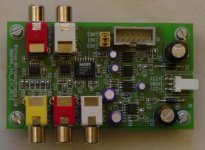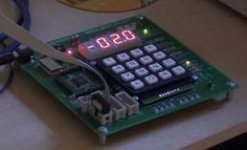Hi all,
Yesterday, with a few friends (Leo, Walter, Guido (gydotron.com) we tried out the digital volume control system from Wolfsom Microelectronics, the WM8816. The WM8816 differs from other similar system like the PGA23xx series in that it comes without an opamp. The chip just contains the control logic, switches and attenuator ladders. Another unusual feature is the constant input impedance (around 7k). In most systems, the input imp. varies with the level setting.
I bought the WM8816 evaluation module shown here, which contains a two channel system with an MC33078 opamp. More on that opamp later. The module also has a subwoofer output, which we didn't use:
Yesterday, with a few friends (Leo, Walter, Guido (gydotron.com) we tried out the digital volume control system from Wolfsom Microelectronics, the WM8816. The WM8816 differs from other similar system like the PGA23xx series in that it comes without an opamp. The chip just contains the control logic, switches and attenuator ladders. Another unusual feature is the constant input impedance (around 7k). In most systems, the input imp. varies with the level setting.
I bought the WM8816 evaluation module shown here, which contains a two channel system with an MC33078 opamp. More on that opamp later. The module also has a subwoofer output, which we didn't use:
Attachments
Continued...
The control was done by the micro-controller board which also is available from Wolfson (I bought all from profusionplc in the UK, btw). This board has a simple interface, but can control up to 3 8816 boards for 5.1 plus subwoofer systems! The 8816 board is about 100 euro's, the controller board about 150.
We tested this system against Guido's passive level control (switched attenuator), using our own favorite music. No blind testing, I'm afraid...
Power amps were LC Audio class-T boards (Good job Lars, I was sceptical but these power amps are first-rate), on Guido's Apogee Scintilla's. This is the control board, set for -2dB attenuation (as is, the range is from +15.5 to -99.5dB). The board also has provisions for peak level detect, mute and balance:
The control was done by the micro-controller board which also is available from Wolfson (I bought all from profusionplc in the UK, btw). This board has a simple interface, but can control up to 3 8816 boards for 5.1 plus subwoofer systems! The 8816 board is about 100 euro's, the controller board about 150.
We tested this system against Guido's passive level control (switched attenuator), using our own favorite music. No blind testing, I'm afraid...
Power amps were LC Audio class-T boards (Good job Lars, I was sceptical but these power amps are first-rate), on Guido's Apogee Scintilla's. This is the control board, set for -2dB attenuation (as is, the range is from +15.5 to -99.5dB). The board also has provisions for peak level detect, mute and balance:
Attachments
How did it sound?
After two hours of all kinds of music, some beers etc, we agreed that the WM8816 made the sound more rough, less smooth than the passive control. But now our problems only began. because, what is 'best' ? Some preferred the passive, because it was more smooth, some preferred the wolfson, because it showed more detail (or so we thought). So, although we DID agree on the difference, we DIDN'T agree on what was preferable. (Right, guys?) Oh, and yes, I caused Guido almost a heartattack when I remarked that on the best of passages, his system came really close to my car stereo. Lucky for me, his sense of humor is as big as his audio savvy.
Anyway, we found that we could comfortably live with either system.
This is Walter (left) and janneman trying to make sense of what they hear:
After two hours of all kinds of music, some beers etc, we agreed that the WM8816 made the sound more rough, less smooth than the passive control. But now our problems only began. because, what is 'best' ? Some preferred the passive, because it was more smooth, some preferred the wolfson, because it showed more detail (or so we thought). So, although we DID agree on the difference, we DIDN'T agree on what was preferable. (Right, guys?) Oh, and yes, I caused Guido almost a heartattack when I remarked that on the best of passages, his system came really close to my car stereo. Lucky for me, his sense of humor is as big as his audio savvy.
Anyway, we found that we could comfortably live with either system.
This is Walter (left) and janneman trying to make sense of what they hear:
What's next?
Leo and one of his friends are putting together a demo board with a PGA23xx. When that's ready, we'll A-B it against the Wolfson, see what that gives.
Anyway, we would be gratefull for any experiences with this stuff anyone had.
Oh, and yes, that MC33078. This was an unknown opamp for me, but apparently it is a specially designed audio opamp. What is interesting is that it has the usual lf rolloff from a few 10's of Hz like they all have, BUT the THD vs freq curve is rather flat until beyond 20kHz. That IS unusual. It looks like they have some clever feedforward stuff inside. Also, another unusual feature is the class A output stage. Anybody using this chip?
Jan Didden
Leo and one of his friends are putting together a demo board with a PGA23xx. When that's ready, we'll A-B it against the Wolfson, see what that gives.
Anyway, we would be gratefull for any experiences with this stuff anyone had.
Oh, and yes, that MC33078. This was an unknown opamp for me, but apparently it is a specially designed audio opamp. What is interesting is that it has the usual lf rolloff from a few 10's of Hz like they all have, BUT the THD vs freq curve is rather flat until beyond 20kHz. That IS unusual. It looks like they have some clever feedforward stuff inside. Also, another unusual feature is the class A output stage. Anybody using this chip?
Jan Didden
janneman said:Nobody ever used that MC33078? Really?
Jan Didden
Really.
But it's on the list.
Jeez, it took some digging to find this thread again. Not many people seems to care about a digital volume control.
I'm almost done with my version of Elektor's "Audio Link", a preamp/volume-control based on the PGA2311PA from TI/BB. This is controlled by a PIC18LF452-I/L from Microchip. Al the parts are soldered on the board except for the analog power supply. Don't like the 7805/7905 combo and some crappy cap's to get a deicent symmetric supply to feed the analog part of the IC. Also managed to program the µcontroller, this was the first time I did this so whe'l call it beginners luck!
So, Janneman in the near future we can have a "Battle of the Best" to see which one performs the better.
Happy listening
Walter
I'm almost done with my version of Elektor's "Audio Link", a preamp/volume-control based on the PGA2311PA from TI/BB. This is controlled by a PIC18LF452-I/L from Microchip. Al the parts are soldered on the board except for the analog power supply. Don't like the 7805/7905 combo and some crappy cap's to get a deicent symmetric supply to feed the analog part of the IC. Also managed to program the µcontroller, this was the first time I did this so whe'l call it beginners luck!
So, Janneman in the near future we can have a "Battle of the Best" to see which one performs the better.

Happy listening
Walter
Good sound - at last
Hi!
I've built a couple of test boards using the PGA2310 chip and I didn't get anyone of them to sound good enough (for me) - they kind of sounded "sloppy". I tried multiple combinations of power supplies and decoupling caps, but it was all the same.
After almost giving up on using a uC-connected chip for volume control I built one last test board with WM8816 and OPA627:s, and I have to say that the sound is incredible! Since my DIY preamp is in progress - awaiting a good enough volume control solution - I currently use a simple volume control with OPA627 (G +1) - 10 kohm pot - OPA627 (G +1), and I cant hear any audible difference between this solution and the WM8816 with OPA627:s.
The awesome thing with the WM8816 is that they let you choose the OP-AMPs yourself, and I'd definitely recommend the combination of WM8816 and OPA627's.
BTW, I'm using batteries to power my WM8816/OPA627 testboard.
Hi!
I've built a couple of test boards using the PGA2310 chip and I didn't get anyone of them to sound good enough (for me) - they kind of sounded "sloppy". I tried multiple combinations of power supplies and decoupling caps, but it was all the same.
After almost giving up on using a uC-connected chip for volume control I built one last test board with WM8816 and OPA627:s, and I have to say that the sound is incredible! Since my DIY preamp is in progress - awaiting a good enough volume control solution - I currently use a simple volume control with OPA627 (G +1) - 10 kohm pot - OPA627 (G +1), and I cant hear any audible difference between this solution and the WM8816 with OPA627:s.
The awesome thing with the WM8816 is that they let you choose the OP-AMPs yourself, and I'd definitely recommend the combination of WM8816 and OPA627's.
BTW, I'm using batteries to power my WM8816/OPA627 testboard.
I have used DS1808 + OPA134 for digitally-controlled volume, and the results are pretty good. The DS1808 is I2C-compatible, which makes it pretty easy to interface with PICs (and most uC's). It doesn't have any kind of zero-crossing detection, so you have to change volumes in a series of small steps to get perfect results. But quite frankly, this is one of the best (lowest distortion, highest dynamics) devices I've found.
Hi Jan,
Thanks to yourself and others for passing on your digital volume control experiences.
Given that a good potentiometer/attenuator might at worst fractionally veil reproduction if not properly buffered, I personally find the risk of irrecoverable ADC>DAC interpolation loss or degradation (roughness) a totally unecessary distraction.
Yes, digital volume controls can work acceptably, but with DIY Audio I am more content knowing that none of the errors that do arise within our reproduction systems could possibly be generated by such additional circuitry, especially when it is not essential, and thus by using a buffered potentiometer my mind remains free to search out other improvements.
Surely digital volume controls are not being developed for the benefit of stereo listeners ?
The digital solution might become preferable in many circumstances, as with surround sound, but a blindly tested subjective preference for closeness to realism versus the objective knowledge of what is truly correct within a discrete aspect of operation, as you are testing, are not the same thing. Thus we need to be on guard lest our internal recognition of what is fundamentally accurate should become distorted by subjectively observed system based preferences.
Cheers ......... Graham.
Thanks to yourself and others for passing on your digital volume control experiences.
Given that a good potentiometer/attenuator might at worst fractionally veil reproduction if not properly buffered, I personally find the risk of irrecoverable ADC>DAC interpolation loss or degradation (roughness) a totally unecessary distraction.
Yes, digital volume controls can work acceptably, but with DIY Audio I am more content knowing that none of the errors that do arise within our reproduction systems could possibly be generated by such additional circuitry, especially when it is not essential, and thus by using a buffered potentiometer my mind remains free to search out other improvements.
Surely digital volume controls are not being developed for the benefit of stereo listeners ?
The digital solution might become preferable in many circumstances, as with surround sound, but a blindly tested subjective preference for closeness to realism versus the objective knowledge of what is truly correct within a discrete aspect of operation, as you are testing, are not the same thing. Thus we need to be on guard lest our internal recognition of what is fundamentally accurate should become distorted by subjectively observed system based preferences.
Cheers ......... Graham.
Re: What's next?
Konnichiwa,
Hmm, did you make a wirebypass test? I usually use that.
I have quite a bit of experience with both Cirrus Logic CS310 and the various PGA231X from Burr Brown plus Nat Semi LM1972. Of those I dislike the LM1972 least, but even that I do not tolerate for long. The others are just plain awful. In all cases tested into a buffer stage with low gain (heavily degenerated 5687 triode operated as common cathode stage with Ra = 3 X Rk) which normally is quiet transparent sonically.
After hearing for example my Power Amp's (beased on Shanling SP-80 Monoblocks) with the PGA2310 Preamp stage or that stage bypassed (I make that switchable) and an external £ 1,500 passive linestage so far eveyone felt that the passive linestage was well worth their money, even if it lacks the remote control convenience of the build in one and costs a lot of extra money.
And all that is different in the signal circuit between "Preamp" in/out is the PGA2310 looped in (the PGA2310 input is permanently connected giving 10K SE or 20K balanced Input impedance, constant with level setting).
I find that any of the Op-Amp's claimed ostensibly to be designed for Audio are not well suited to audio applications, examples include NE5534, NE5534, OPA604, LM833 and that AD/SSM one (forgot type). The Motorola Part may be an exception, but i doubt it.
Sayonara
Konnichiwa,
janneman said:After two hours of all kinds of music, some beers etc, we agreed that the WM8816 made the sound more rough, less smooth than the passive control. But now our problems only began. because, what is 'best' ?
Hmm, did you make a wirebypass test? I usually use that.
janneman said:Anyway, we would be gratefull for any experiences with this stuff anyone had.
I have quite a bit of experience with both Cirrus Logic CS310 and the various PGA231X from Burr Brown plus Nat Semi LM1972. Of those I dislike the LM1972 least, but even that I do not tolerate for long. The others are just plain awful. In all cases tested into a buffer stage with low gain (heavily degenerated 5687 triode operated as common cathode stage with Ra = 3 X Rk) which normally is quiet transparent sonically.
After hearing for example my Power Amp's (beased on Shanling SP-80 Monoblocks) with the PGA2310 Preamp stage or that stage bypassed (I make that switchable) and an external £ 1,500 passive linestage so far eveyone felt that the passive linestage was well worth their money, even if it lacks the remote control convenience of the build in one and costs a lot of extra money.
And all that is different in the signal circuit between "Preamp" in/out is the PGA2310 looped in (the PGA2310 input is permanently connected giving 10K SE or 20K balanced Input impedance, constant with level setting).
janneman said:Oh, and yes, that MC33078. This was an unknown opamp for me, but apparently it is a specially designed audio opamp.
I find that any of the Op-Amp's claimed ostensibly to be designed for Audio are not well suited to audio applications, examples include NE5534, NE5534, OPA604, LM833 and that AD/SSM one (forgot type). The Motorola Part may be an exception, but i doubt it.
Sayonara
- Status
- This old topic is closed. If you want to reopen this topic, contact a moderator using the "Report Post" button.
- Home
- Amplifiers
- Solid State
- Digital/analog volume control experience


